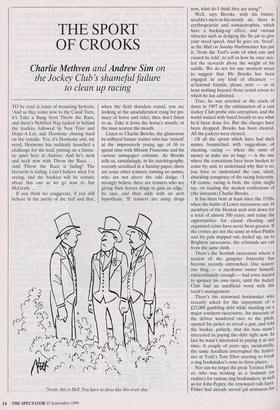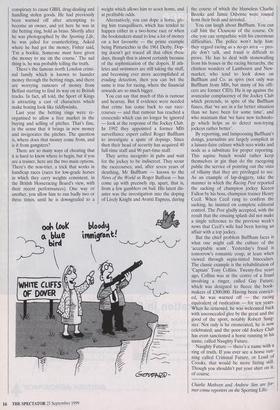THE SPORT OF CROOKS
Charlie Methven and Andrew Sim on
the Jockey Club's shameful failure to clean up racing
TO be read in tones of mounting hysteria: `And as they come now to the Canal Turn, it's Take a Bung from Throw the Race, and there's Nobbled Nag tucked in behind the leaders, followed by Non Trier and Dope-A-Lot; and Hormone chasing hard on the outside. Yes, it's Hormone and, my word, Hormone has suddenly launched a challenge for the lead, putting on a fantas- tic spurt here at Aintree. And he's neck and neck now with Throw the Race.... And Throw the Race is fading! The favourite is fading. I can't believe what I'm seeing, and the bookies will be ecstatic about this one as we go now to Jim McGrath. . . '
If you think we exaggerate, if you still believe in the purity of the turf and that, when the field thunders round, you are looking at the unadulterated vying for pri- macy of horse and rider, then don't listen to us. Take it from the horse's mouth, or the man nearest the mouth.
Listen to Charlie Brooks, the glamorous be-trilbyed former trainer who has 'retired' at the impressively young age of 36 to spend time with Miriam Francome and his various newspaper columns. As Brooks tells us, tantalisingly, in his autobiography, recently serialised in a Sunday paper, there are some other trainers, naming no names, who are not above the odd dodge. 'I strongly believe there are trainers who are giving their horses drugs to gain an edge,' he says, and then adds with an arch hypothesis, 'If trainers are using drugs Yessir, this is Hell. You have to dress like this every day.' now, what do I think they are using?'
Well, says Brooks, with his butter- wouldn't-melt-in-his-mouth air, there is erythropoietin and somatotrophin, which have a bucking-up effect, and various wheezes such as dodging the flu jab to give your steed speed. And he goes on, 'freed', as the Mail on Sunday blurbmeister has put it, 'from the Turfs code of what can and cannot be told', to tell us how he once mis- led the stewards about the weight of his saddle. We do not for one moment mean to suggest that Mr Brooks has been engaged in any kind of chicanery — m'learned friends, please note — or at least nothing beyond those venial errors to which he has admitted.
True, he was arrested at the crack of dawn in 1997 at the culmination of a vast Jockey Club probe into corruption, and the world waited with bated breath to see what he'd been done for. But the charges have been dropped. Brooks has been cleared. All the jockeys were cleared.
Of all the sports which have had their names besmirched with suggestions of cheating, racing — where the sums of money at stake are so huge — is the one where the convictions have been hardest to come by; and, to understand why that is so, you have to understand the vast, silent, chuckling conspiracy of the racing fraternity. Of course, racing is bent, the cynic might say, on reading the modest confessions of (the innocent) Charlie Brooks.
It has been bent at least since the 1930s, when the battle of Lewes racecourse saw 16 members of the Hoxton mob sent down for a total of almost 500 years; and today the opportunities for casual cheating and organised crime have never been greater. If the crimes are not the same as when Pinkie and his pals stepped out, tooled up, on to Brighton racecourse, the criminals are cut from the same cloth.
There's the Scottish racecourse where a section of the gangster fraternity has become recently entrenched. One notori- ous thug — a racehorse owner himself, extraordinarily enough — had even started to sponsor his own races, until the Jockey Club had an unofficial word with the track's management.
There's the renowned bookmaker who recently asked for the repayment of a £25,000 gambling debt while standing on a major southern racecourse. An associate of the debtor wandered over to the pitch, opened his jacket to reveal a gun, and told the bookie, politely, that his boss wasn't interested in paying the debt right now. In fact he wasn't interested in paying it at any time. A couple of years ago, incidentally, the same hoodlum interrupted the festivi- ties at York's Tote Ebor meeting to break a ring bookmaker's nose in three places.
Nor can we forget the great Terence Fish- er, who was working as a hodman (or cashier) for various ring bookmakers, as well as for John Pegley, the renowned rails layer. Fisher had already served jail sentences for
conspiracy to cause GBH, drug-dealing and handling stolen goods. He had previously been warned off after attempting to become an owner, and yet here he was in the betting ring, bold as brass. Shortly after he was photographed by the Sporting Life, he was jailed for counterfeiting. Asked where he had got the money, Fisher said, `I'm a bookie. Someone must have given the money to me on the course.' The sad thing is, he was probably telling the truth.
There's the famous north London crimi- nal family which is known to launder money through the betting rings, and there are worrying rumours of money from Belfast starting to find its way on to British tracks. In fact, all told, the Sport of Kings is attracting a cast of characters which make boxing look like tiddlywinks.
Last year the betting rings were re- organised to allow a free market in the buying and selling of pitches. That's fine, in the sense that it brings in new money and invigorates the pitches. The question is, where does that money come from, and is it from gangsters?
There are so many ways of cheating that it is hard to know where to begin, but if you are a trainer, here are the two main options. There's the non-trier, a trick that works in handicap races (races for low-grade horses in which they carry weights consistent, in the British Horseracing Board's view, with their recent performances). One way or another, you allow him to run badly two or three times, until he is downgraded to a weight which allows him to scoot home, and at profitable odds.
Alternatively, you can dope a horse, giv- ing him tranquillisers, which has tended to happen either in a two-horse race or when the bookmakers stand to lose a lot of money on a hot favourite — the prime example being Pinturicchio in the 1961 Derby. Dop- ing doesn't get traced all that often these days, though that is almost certainly because of the sophistication of the dopers. If ath- letes and swimmers are still taking the stuff, and becoming ever more accomplished at evading detection, then you can bet the same is true for racing, where the financial rewards are so much bigger.
You can say that much of this is rumour and hearsay. But if evidence were needed that crime has come back to our race- courses — and that rumour has reached a crescendo which can no longer be ignored — look at the response of the Jockey Club. In 1992 they appointed a former MI6 surveillance expert called Roger Buffham to investigate a spate of dopings. Since then their head of security has acquired 40 full-time staff and 90 part-time staff.
They arrive incognito in pubs and wait for the jockey to be indiscreet. They scour the racecourses; and, after seven years of sleuthing, Mr Buffham — known to the News of the World as Roger Buffoon — has come up with precisely zip, apart, that is, from a few gamblers on bail. His latest dis- aster was the investigation into the doping of Lively Knight and Avanti Express, during
the course of which the blameless Charlie Brooks and Jamie Osborne were roused from their beds and arrested.
You can laugh about Buffham. You can call him the Clouseau of the course. Or else you can sympathise with his enormous difficulties, The police won't help him: they regard racing as a no-go area — peo- ple don't talk, and fraud is difficult to prove. He has to deal with stonewalling from his bosses in the racing hierarchy, the chinless wonders of Lambourn and New- market, who tend to look down on Buffham and Co. as spivs (not only was Buffham from MI6, but many of his offi- cers are former CID). He is up against the avuncular complacency of the Jockey Club which pretends, in spite of the Buffham fiasco, that 'we are in a far better situation than we have been for some time', and who maintain that 'we have new technolo- gy which helps us to detect non-trying jockeys rather better'.
By reporting, and lampooning Buffham's doings, journalists are largely complicit in a laissez-faire culture which sees winks and nods as a substitute for proper reporting. This supine bunch would rather keep themselves in gin than do the racegoing public the service of pointing out the vista of villainy that they are privileged to see. As an example of lap-doggery, take the manner in which the Racing Post reported the sacking of champion jockey Kieren Fallon by his boss, champion trainer Henry Cecil. When Cecil rang to confirm the sacking, he insisted on complete editorial control. The Post gladly accepted, with the result that the ensuing splash did not make a single reference to the previous week's news that Cecil's wife had been having an affair with a top jockey.
But the chief problem Buffham faces is what one might call the culture of the `acceptable scam'. Yesterday's fraud is tomorrow's romantic coup, at least when viewed through sepia-tinted binoculars. The classic example is the rehabilitation of `Captain' Tony Collins. Twenty-five years ago, Collins was at the centre of a fraud involving a ringer, called Gay Future, which was designed to fleece the book- makers of £300,000. Having been convict- ed, he was warned off — the racing equivalent of rustication — for ten years. When he returned, he was welcomed back with unconcealed glee by the great and the good of the sport, notably Robert Sang- ster. Not only is he exonerated, he is now celebrated; and the poor old Jockey Club has even sanctioned a horse running in his name, called Naughty Future. Naughty Future — there's a name with a ring of truth. If you ever see a horse run- ning called Criminal Future, or Load of Crooks, that would he more fitting still. Though you shouldn't put your shirt on it, of course.
Charlie Methven and Andrew Sim are for- mer crime reporters on the Sporting Life.



























































































 Previous page
Previous page